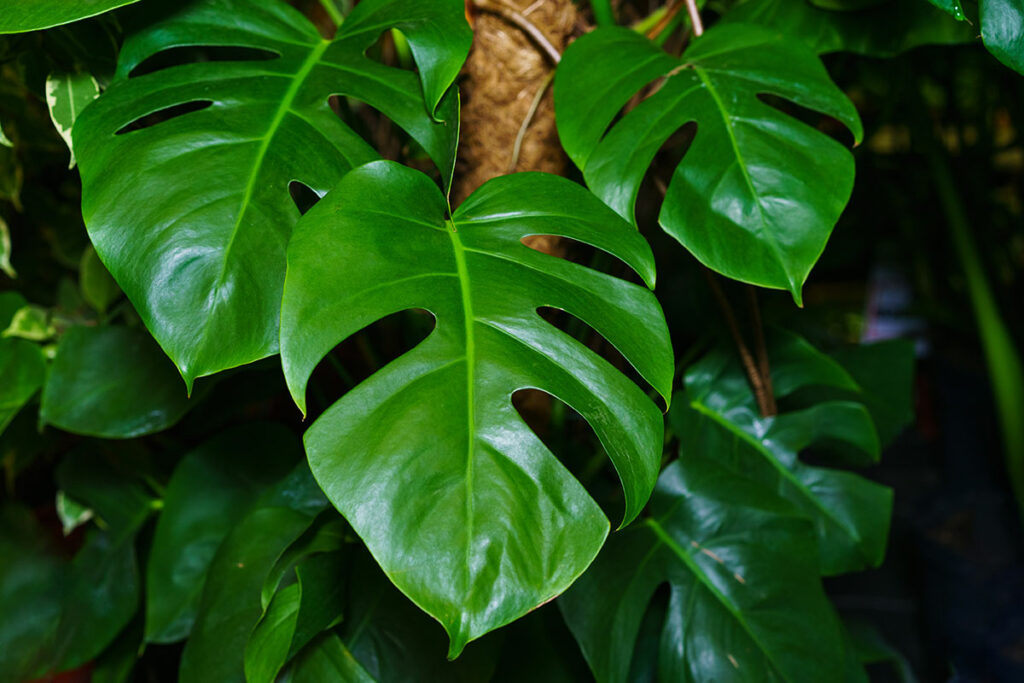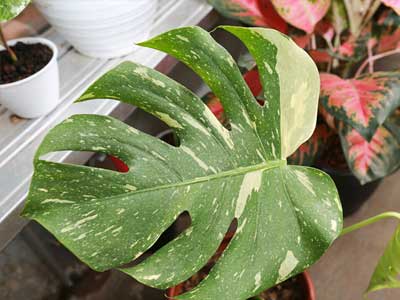
Monstera plants, also known as “Swiss cheese plants,” are a popular and eye-catching addition to any indoor or outdoor space. These tropical plants are native to the rainforests of Central America, where they’re naturally inclined to climb trees and other structures. If you’re interested in encouraging your Monstera plant to climb, this article covers some helpful tips and techniques to get you started on your plant’s climbing journey.
Providing the proper support is key to helping your Monstera plant effectively climb. While there are many options available, some popular choices include using moss poles, trellises, or even DIY frames made from durable materials such as wood or metal. These supports will allow your Monstera to latch onto a structure with its aerial roots and grow upward, creating an impressive visual display.
Before you start, it’s important to assess the individual needs and preferences of your Monstera plant, considering factors such as the plant’s size and the amount of available light. By providing the right environment and support, you’ll soon have a thriving, climbing Monstera that not only enhances the aesthetic of your space but also facilitates the plant’s overall health and well-being.
Understanding Monstera Plants
Monstera plants, also known as Swiss cheese plants or Monstera deliciosa, are tropical plants known for their distinctive large, split leaves. Native to Central and South America, these plants have become a popular choice for indoor gardens. In this section, you’ll learn about the Monstera plant’s characteristics and the ideal environment for them to thrive.
First, let’s take a look at the growth pattern and care requirements of Monstera plants. Here are some key points to consider:
- Light: Monstera plants prefer bright, indirect light. Avoid placing them in direct sunlight, as this can scorch their leaves.
- Water: Water your Monstera regularly, allowing the soil to dry out slightly between waterings. Be careful not to overwater, as this can lead to root rot.
- Humidity: As tropical plants, Monsteras thrive in higher humidity levels. A humidity level of 60% or higher is ideal, but they can tolerate levels as low as 40%.
- Growth rate: Monstera plants can grow quite rapidly, with new mature leaves appearing every few weeks.
A key aspect of Monstera plants’ growth is their climbing behavior, which occurs naturally in their native rainforest habitats. In the wild, Monsteras use their long aerial roots to climb up trees and other structures, reaching for sunlight. This climbing behavior allows them to grow faster, as they receive more light and air circulation than they would if they remained at the forest floor level.
When growing Monstera plants indoors, mimicking this climbing behavior allows the plant to flourish and display its characteristic split leaves. To do so, you can provide your plant with support structures such as moss poles, trellises, or wooden stakes. Since Monstera plants are natural climbers, they will attach their aerial roots to these supports and start climbing up effortlessly.
So, now that you have a better understanding of Monstera plants’ characteristics and their natural climbing behavior, you’re ready to provide your Monstera with optimal conditions to help it climb and thrive.
Climbing Mechanism of Monstera Plants

Monstera plants are not only gorgeous, but they are also climbers by nature. To help your Monstera reach its full potential, it’s essential to understand its climbing mechanism. So, let’s dive into how Monstera plants climb and how you can support their growth.
Monstera plants are epiphytes, which means they derive their nutrients from the air and surrounding environment rather than soil. In their natural habitat, these plants climb on nearby trees or other supports to get closer to sunlight sources. They use specialized structures called aerial roots to achieve this.
Here are the primary parts of Monstera’s climbing mechanism:
- Aerial Roots: Monstera plants produce long, thick roots that grow outward. These aerial roots seek and attach themselves to available structures.
- Leaves: As your Monstera plant climbs, its leaves will expand to capture more sunlight. This aspect is beneficial to the plant’s overall health and can directly impact its growth rate.
- Petioles: The stalks that connect the leaves to the main stem, petioles, grow longer as the plant climbs, providing more room for growth and anchorage.
Now that you have a basic understanding of how Monstera plants climb naturally, you can provide an appropriate environment and support system for your own plant. Here are some tips:
- Support: Offer your Monstera a moss pole, trellis, or another sturdy support to climb on. This will not only encourage natural growth habits, but it will also save space in your home and make it easier to care for your plant.
- Humidity: Ensure the surrounding environment has adequate humidity levels (around 50-60%). This will help keep the aerial roots healthy and promote growth.
- Pruning: Prune your Monstera occasionally to encourage the growth of new leaves and aerial roots. This will help maintain a healthy climbing structure and provide space for new growth.
With proper knowledge of Monstera’s climbing mechanisms and care, you can create a thriving environment for your plant to grow and climb. Just remember to provide the right support, humidity, and pruning, and you’ll enjoy watching your Monstera thrive.
How to Encourage Monstera Plants to Climb
Monstera plants are known for their beautiful, fenestrated leaves and their ability to climb. In this section, we’ll explore different methods to help your monstera plant climb, flourish, and become a stunning focal point in your space.

Choosing the Right Support
When selecting a support for your monstera plant to climb, it’s essential to choose one that is both sturdy and attractive. Consider the following options:
- Bamboo stakes: These are lightweight, inexpensive, and can be easily found at most garden stores.
- Wooden trellis: A wooden trellis provides a decorative and supportive surface for your monstera plant to climb.
- Metal grid: This option offers a modern aesthetic while also being very sturdy.
Using Moss Poles
Moss poles are among the most popular supports for monstera plants, and they’re easy to set up. Here’s how:
- Purchase or make a moss pole: You can buy a pre-made moss pole or make your own by wrapping a PVC pipe in sphagnum moss and securing it with twine or fishing line.
- Insert the moss pole: Gently push the moss pole into the soil near the base of your monstera plant, taking care not to damage the roots.
- Secure the plant: Use plant ties or soft twine to gently attach the plant to the moss pole, allowing room for growth.
Tip: Keep the moss pole moist by misting it with water regularly. This will encourage the monstera plant to form aerial roots, which will help it cling to the moss pole.
Coaxing Techniques
To encourage your monstera plant to climb, try these simple coaxing techniques:
- Prune lower leaves: Gently prune the lower leaves of your monstera plant to direct its energy towards climbing. Make sure to sterilize your pruning shears before and after use.
- Rotate the plant: Regularly rotate your monstera plant so that all sides receive equal light. This will help encourage the plant to climb upwards instead of leaning to one side.
- Gradually increase support height: As your monstera plant grows, add more support to help it continue climbing. For example, if you’re using a trellis or metal grid, add additional sections.
By providing your monstera plant with the right support and encouraging it to climb, you’ll be able to enjoy a healthy, thriving plant that adds a stunning visual appeal to your space.

Maintaining Climbing Monstera Plants
Caring for a climbing Monstera plant requires some specific techniques to ensure its healthy growth and development. In this section, we’ll discuss the essential maintenance steps: * Pruning Techniques* and Regular Check-ups. By following these tips, you’ll be on your way to a thriving, gorgeous Monstera.
Pruning Techniques
Pruning is crucial to maintain your Monstera’s shape and promote new growth. Here are a few pruning tips to incorporate into your plant care routine:
- Trim away dead or yellowing leaves: This will allow your plant to direct its energy toward healthier parts.
- Pinch back new growth: By pinching off the tips of new growth, you’ll encourage your plant to grow bushier.
- Remove aerial roots: If your Monstera is becoming too unruly, consider trimming away some of the aerial roots. Be cautious not to remove too many, as they help the plant anchor itself when climbing.
Remember to always use clean and sharp pruning shears, and make clean cuts to prevent the risk of infection.
Regular Check-ups
It’s essential to give your climbing Monstera plant regular check-ups to ensure optimal growth. Stick to these simple steps:
- Monitor for pests: Keep an eye out for any signs of pest infestation, such as discoloration, tiny web-like structures, or sticky residue on leaves. If you spot any pests, treat your Monstera with a horticultural oil or insecticidal soap.
- Check the support structure: Examine your plant’s support structure (like a moss pole or trellis) for stability. If needed, add more ties to secure your Monstera to its support.
- Rotate your plant: To ensure your Monstera receives equal amounts of sunlight on all sides, rotate the plant every few weeks. This will promote even growth and prevent it from leaning too much to one side.
Incorporating these maintenance tips into your plant care routine will help your Monstera stay strong and beautiful while it climbs. Happy growing!
Frequently Asked Questions
What type of support is best for Monstera plants?
A moss pole or a sturdy trellis works well for Monstera plants. These provide adequate support and mimic their natural climbing habits. Choose a support made of natural materials like wood, (e.g., dowels or bamboo stakes) or coir, a fiber derived from coconut husks.
How can I make a moss pole for my Monstera?
To make a moss pole, you’ll need:
- A PVC pipe or wooden dowel.
- Sphagnum moss (soaked in water for a few minutes).
- Garden twine or wire.
Secure a layer of moss around the pipe or dowel using twine or wire, starting from the bottom. Make sure the moss layer is at least one inch thick. Continue wrapping the moist moss with twine or wire until you reach the desired height. Insert the moss pole into your Monstera’s pot, making sure it’s anchored well.
What is the ideal method of Monstera trellis attachment?
When attaching your Monstera to a trellis, gently coax the plant’s stems towards the structure without applying too much force, as this may cause damage. Use soft plant ties, such as Velcro or cloth ties, to secure the stems in place. Make sure not to tie too tightly, allowing wiggle-room for growth and movement.
How can I promote healthy climbing for my Monstera adansonii?
Encourage healthy climbing by ensuring your Monstera adansonii receives adequate indirect sunlight, consistent watering, and occasional misting. Additionally, provide a suitable climbing support, such as a moss pole or trellis. Regularly check for signs of struggle or stress and make necessary adjustments to the plant’s environment and care routine.
What is the proper care for a climbing Monstera?
Proper care for a climbing Monstera includes:
- Watering when the top inch of soil feels dry.
- Providing bright, indirect sunlight.
- Maintaining a high level of humidity through misting, a humidifier, or placing the plant on a pebble tray.
- Fertilizing with a balanced, water-soluble fertilizer every 1-2 months during the growing season.
- Pruning to maintain the desired size and shape.
How can I encourage aerial roots and growth in my Monstera?
Aerial roots can be encouraged by providing support, such as a moss pole or trellis, and maintaining a high humidity level. Occasionally mist your Monstera’s aerial roots and support structure to keep them moist, which will promote growth. Additionally, ensure your Monstera receives adequate nutrients by providing a balanced, water-soluble fertilizer during the growing season.





